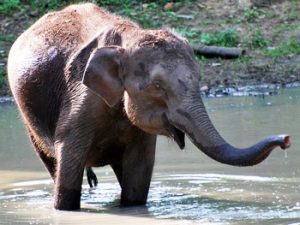Kabini and Bhadra, India: Life Unfolds by the Riverside
Lakshmi Sharath treks through the jungles of Southern India, coming in close contact with elephants, spotted deer, peacocks, among other wild animals. Read more about Sharath’s safari inside Rajiv Gandhi National Park!

A fury of colors hits the eye as the jungle unfolds itself into a collage of greens, yellows and browns. I squint through the trees and wonder, like Macbeth, if the woods are moving.
Driving through the serpentine tracks lined by teakwood, it feels like I am rallying down a dirt track. The journey, however, abruptly ends near a small murky pool, surrounded by dense undergrowth.
I wait in the open jeep, with a bunch of motley tourists, lost in the forests of Karnataka, located deep down in the southern part of India. Sleepy and tired after a five-hour drive from the urban sprawl of Bangalore, we are in the midst of a safari inside a national park.
The forest is called Nagarhole in the local language, referring to the many streams that snake through this jungle. As a country, we have a penchant for naming our streets, buildings and even memorials after our leaders. The forests are no exception. Nagarhole therefore became Rajiv Gandhi National Park in the guide books, named after our former Prime Minister.
The sun turns golden , creating patterns on the waters. Nudged by the breeze, the branches of the trees stoop down to caress them, teasing them as the ripples form. We stop, wait and hope that a wild beast will soon cross our path.
Our naturalist whispers, “This is the tiger’s pool; usually they come here at this hour to drink some water.” Leopards, he adds, avoid a clash with the tigers by arriving a few minutes early. But neither of the wild cats are probably thirsty enough to appear.
The backwaters of Kabini
As we meander through the woods, the path takes us down to the backwaters of the River Kabini. This is the moment that we are all waiting for. The blue green waters with forests on both banks, the sun-lit bamboo trees, the golden-streaked sky blind you for a moment.
But the real showstoppers are the elephants. Hundreds parade down the banks of Kabini, basking in the sun, dancing, swimming, tearing and feeding on the bamboos. The forests belong to them. The tuskers loom large as a couple of them are locked in a conflict. A trio dance their way into the forest. Awed by their sheer size, we stop by to record the phenomenon.
As cameras come out, our naturalist says that large families with calves migrate to these backwaters every summer looking for food. “This is Asia’s largest congregation of elephants,” he announces, explaining that the forest was once the hunting ground of the Mysore Maharaja. A dam was built on the river, creating these backwaters which separated the forests — Nagarhole and Bandipur. To the elephants however, it is one seamless home with a perennial supply of food.
